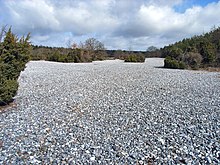Narrow heather


The narrow heath is a 9.5 kilometers long and about two kilometers wide spit between the Baltic seaside resort of Binz and the town of Neu Mukran near Sassnitz on the island of Rügen . It lies in the area of the municipality of Binz and is bounded in the northwest by the Kleiner Jasmunder Bodden and in the east by the Prorer Wiek .
Emergence
The design of the strongly structured coastline of Rügen was an interplay of sea level fluctuations and land uplift processes after the last ice age ( Vistula ice age ).
It is assumed that the area of today's Western Pomerania Baltic Sea coast was ice-free for about 13,000 years after the last glacial advance (Nordrügen-Ostusedomer Staffel), but was largely mainland. Due to the Ice Age, the level of the world's oceans was considerably lower than it is today. Around 9000 years ago, a meltwater lake (the Ancylus-Großsee ) built up, which reached a maximum sea level of eight meters below sea level. However, after a total period of around 1000 years, this partially quickly drained into the ocean, which led to a renewed mainland phase (Ancylus regression ). Only 8000 years ago - after a general rise in the world's oceans - the sea level in the Baltic Sea basin began to rise rapidly by 15 m due to the flooding of the land bridge between Denmark and Scandinavia (Litorina Sea) and almost reached the current level 5500 years ago.
Since that time, the sea level has fluctuated only by one to two meters and a coastal compensation process began that continues to this day. In particular, the cliff coasts of Rügen are removed by surf and ocean currents and the sediments are deposited again as sand and rubble between the island cores as spits and hooks.
The narrow heath is located in an old glacier tongue basin between the island cores Jasmund and Granitz . As geological boreholes near Prora in the middle of the spit show, the surf of the Ancylus lake has already deposited an eleven meter high layer of sediment, which was later increased by another ten meters by the Litorina Sea. Here one beach wall was deposited in front of the other, whereby the spit of the Schmalen Heide reached its current width of about two kilometers. In intermediate phases, the material deposited by currents and surf consisted - to a greater extent than today - of flint bulbs that were washed out of the chalk cliffs of the Jasmund peninsula. This led to the creation of the unique flint fields near Neu Mukran in the north of the Schmalen Heide, which have been under nature protection since 1935.
Nature reserves
The protection purpose of the nature reserve Schmale Heide and Feuersteinfelder consists primarily in the preservation of the approx. 14 exposed flint walls on an area of 2000 × 200 m. In order to push back the vegetation spreading there, parts of the flint fields were fenced in in the middle of the 19th century and stocked with game, which was supposed to counteract the encroachment by browsing after the narrow heath was reforested with pines around 1840. From the mid-1970s to the early 1990s, this was attempted again using European mouflons . The entire extent of the flint fields is currently freely accessible.
East of the flint fields, a new nature reserve Schmale Heide und Feuersteinfelder - Extension was created in 1994 , which serves to protect the dune area near the beach, in which vegetation partly consisting of rare plants thrives. In this area, the marked paths must not be left to protect the sensitive dune vegetation.
Influences on the landscape
In contrast to the Schaabe , the landscape of the Schmalen Heide has been shaped significantly since the 1930s by the construction of the KdF seaside resort Rügen in Prora and subsequent decades of military use with the associated infrastructure. In addition to the approximately five-kilometer-long building complex along the Prorer Wiek, which mainly served as barracks, large parts of the heath landscape and the Prora , a wooded chain of hills in the southern part of the narrow heath, were used as military training areas and for the construction of ammunition stores, vehicle halls and workshops used.
The beach on the Prorer Wiek, which has been accessible again since the beginning of the 1990s, has regained its popularity as a bathing beach.
literature
- Ralf-Otto Niedermeyer, Heinz Kliewe, Wolfgang Jahnke: The Baltic coast between Boltenhagen and Ahlbeck. A geological and geomorphological overview with excursion tips (= geographic building blocks. New series, issue 30). Hermann Haack / Geographisch-Kartographische Anstalt, Gotha 1987, ISBN 3-7301-0633-3 .
Coordinates: 54 ° 26 ′ 11.4 " N , 13 ° 34 ′ 7.7" E

